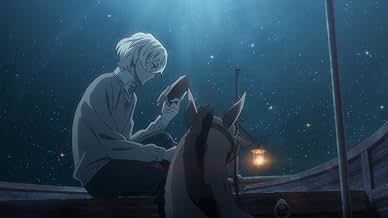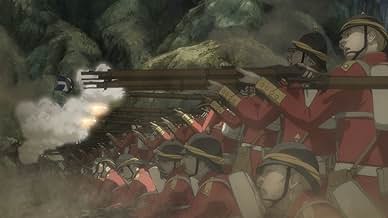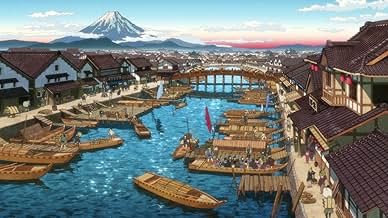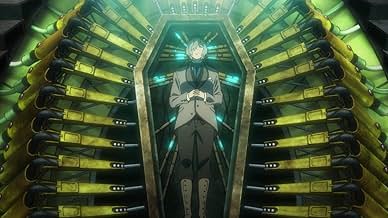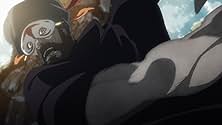NOTE IMDb
6,0/10
1,5 k
MA NOTE
Ajouter une intrigue dans votre langueAfter breaking the law of reanimating human corpses, young Watson has to either work for the government or face punishment. He has to go on a secret mission, to find the notes of Viktor Fran... Tout lireAfter breaking the law of reanimating human corpses, young Watson has to either work for the government or face punishment. He has to go on a secret mission, to find the notes of Viktor Frankenstein, who reanimated the first human corpse.After breaking the law of reanimating human corpses, young Watson has to either work for the government or face punishment. He has to go on a secret mission, to find the notes of Viktor Frankenstein, who reanimated the first human corpse.
- Réalisation
- Scénario
- Casting principal
- Récompenses
- 2 nominations au total
Clint Bickham
- Additional Voices
- (English version)
- (voix)
Pietro Biondi
- L'Uno
- (voix)
Anthony Bowling
- Additional Voices
- (English version)
- (voix)
Duncan Brannan
- Additional Voices
- (English version)
- (voix)
Justin Briner
- Additional Voices
- (English version)
- (voix)
Ben Bryant
- Additional Voices
- (English version)
- (voix)
Chris Burnett
- Additional Voices
- (English version)
- (voix)
Bradley Campbell
- Additional Voices
- (English version)
- (voix)
Clifford Chapin
- Additional Voices
- (English version)
- (voix)
Greg Dulcie
- Grant
- (English version)
- (voix)
R. Bruce Elliott
- 1
- (English version)
- (voix)
Ricco Fajardo
- Additional Voices
- (English version)
- (voix)
Issei Futamata
- Narrator
- (voix)
Avis à la une
This film takes a well known story of Dr Frankenstein and adds a different spin on the ideas of death.
I thoroughly enjoyed it and was one of the first anime films i watched outside the Studio Ghibli collection. The idea of bringing corpses back from the dead as working puppets, is a very dark matter and i believe this film manages to convey its story.
However it may of helped me relate to the characters and have a better understanding towards their motives, if more background was given into their lives.
Enjoyed so much have ordered myself the steel-book blu ray version to enjoy :)
I thoroughly enjoyed it and was one of the first anime films i watched outside the Studio Ghibli collection. The idea of bringing corpses back from the dead as working puppets, is a very dark matter and i believe this film manages to convey its story.
However it may of helped me relate to the characters and have a better understanding towards their motives, if more background was given into their lives.
Enjoyed so much have ordered myself the steel-book blu ray version to enjoy :)
While the Empire of Corpses is by far one of my most favorite films of all time, you have to be prepared to go full in when watching it. It's not your typical anime movie, it deals with big problems, and stuffs so much into its 2 hour and 6 min run time, that I found myself watching it twice just to process it all. The animation is stunning, the characters believable and ''human'' and the overarching question of what it means to have a soul really makes this film. The ending (as you'll find most people were unhappy with) is due to the writer passing away before finishing. After learning this I take it as creative liberty on the co-writer's behalf, as I believe we'll never know the true ending the writer was aiming for. To sum this up, I give this movie a 9/10, the 9 only because of the ending. Which I noted before I can look past.
¨Empire of the Corpses¨ is a potpourri of many enticing ingredients that do not all come together perfectly, nor do they all stick together very well. It has an exciting starting point: Wars are fought by the dead, factories are run by Zombies, and even the streets are wandered by the living. After breaking the law that prohibits the reanimation of human corpses, young Watson is faced with a dilemma: work for the government or accept his punishment. In Victorian England, the science of resurrecting the dead was discovered. Based on the findings of Viktor Frankenstein's research and the knowledge of the weight of the soul at 21 grams, a corpse can be revived by injecting it with an artificial soul substance. However, it has no real soul and cannot articulate itself, among other things. However, this research has revolutionized all areas of life. It is then that young Watson is sent on a secret mission to find the notes of Viktor Frankenstein, the man who managed to reanimate a corpse for the first time. He is accompanied by other agents with their own secrets and their own personal agendas. The dead will inherit the Earth!
This high-budget film, produced by the Wit studio (Attack on Titan), started in Japanese theaters in October 2015, and subsequently circulated around the world. It is the first installment of the trilogy that adapts the novels written by Project Itoh and Tó Enjo to anime. ¨The Empire of Corpses¨ (Shisha no teikoku, 2015) is followed by ¨Harmony¨ and ¨Genocidal Organ¨. The author Project Itoh is the pseudonym of Satoshi Ito, the creator of the novels, who died of cancer just after finishing writing ¨Harmony¨, the second installment.
The film takes the viewer into an alternative world, set in the 19th century, after the American Civil War (1861-1865) with a wide variety of events, these at first glance seem completely incompatible, but eventually unfold with an undeniable fascination. In short, it is a sci-fi steampunk horror thriller with undead and many roles that also belongs to the genre of alternative history along with the apocalyptic atmosphere. It stars the famous young Doctor Watson who after breaking the law of reanimating human corpses, has to go on a secret mission, to find the notes of Viktor Frankenstein, the well-known scientist from Mary Shelley's novel who reanimated the first human corpse. The characters are kept quite simple and sometimes seem a bit too heterogeneous in the very detailed environment. The drawings are simple but slenderly developed with the classic big Japanese eyes of animation and following the anime style. The use of CGI, on the other hand, is very professional, so a carelessly animated CGI model does not disturb the overall visual impression at any point. The apocalyptic conclusion, in particular, is a masterpiece of modern anime art and a real feast for any fan of breathtaking animations.
In "Empire of Corpses" (2015) several mythical figures from popular culture, classical literature and legends have been mixed into a colorful potpourri. Thus, the film features real or fictional historical figures that you have to watch very carefully and also have some prior knowledge to discover them all, such as for example: the American president Ulysses Simpson Grant, but also the character of Arthur Conan Doyle, John Watson, the notorious inventor Thomas Edison, a supposed descendant of the Russian Romanov dynasty called Karamazov, Dr. Viktor Frankenstein, Frankenstein's monster himself, the mythical American character Paul Bunyan, and even Sherlock Holmes and Irene Adler. And adding the imaginary submarine Nautilus devised by Jules Verne for his magnum opus 20,000 Leagues Under the Sea, although in the film it is supposedly designed by Thomas Edison himself.
But this 'heterogeneous conglomeration' of strange situations, a multitude of peculiar characters and varied incidents, is both a strong point and a weak point of the film at the same time. The plot, which consists of predictable twists and one-dimensional characters, is only intended to serve as a means of transporting us to the aforementioned alternative worlds on the one hand and deep philosophical questions on the other. The characters remain completely inconsequential, they are neither particularly sympathetic nor unsympathetic and at some point the viewer loses interest in their fate. Unfortunately, the philosophical approach also remains superficial. Many more questions are raised than could be answered or even addressed, which makes the entire film degenerate into a series of unanswered questions, various briefly addressed philosophical themes and arbitrary script elements.
While the visuals are certainly one of the best that modern animation art has to offer, the storyline turns out to be an uneven melting pot, being sadly nothing more than a compendium of shallow philosophical themes and meaningless musings. But still, the potential is there and you can look forward to the next parts: ¨Harmony¨ y ¨Genocidal Organ¨. The film despite its flaws and some cracks, was well directed by Ryôtarô Makihara Makihara. He is known for Summer Wars (2009), Vampire in the Garden (2022) and The Empire of Corpses (2015), among others. This is acceptable but it drags on and takes at least half an hour to waste over the duration of the film. Rating: 6/10.
This high-budget film, produced by the Wit studio (Attack on Titan), started in Japanese theaters in October 2015, and subsequently circulated around the world. It is the first installment of the trilogy that adapts the novels written by Project Itoh and Tó Enjo to anime. ¨The Empire of Corpses¨ (Shisha no teikoku, 2015) is followed by ¨Harmony¨ and ¨Genocidal Organ¨. The author Project Itoh is the pseudonym of Satoshi Ito, the creator of the novels, who died of cancer just after finishing writing ¨Harmony¨, the second installment.
The film takes the viewer into an alternative world, set in the 19th century, after the American Civil War (1861-1865) with a wide variety of events, these at first glance seem completely incompatible, but eventually unfold with an undeniable fascination. In short, it is a sci-fi steampunk horror thriller with undead and many roles that also belongs to the genre of alternative history along with the apocalyptic atmosphere. It stars the famous young Doctor Watson who after breaking the law of reanimating human corpses, has to go on a secret mission, to find the notes of Viktor Frankenstein, the well-known scientist from Mary Shelley's novel who reanimated the first human corpse. The characters are kept quite simple and sometimes seem a bit too heterogeneous in the very detailed environment. The drawings are simple but slenderly developed with the classic big Japanese eyes of animation and following the anime style. The use of CGI, on the other hand, is very professional, so a carelessly animated CGI model does not disturb the overall visual impression at any point. The apocalyptic conclusion, in particular, is a masterpiece of modern anime art and a real feast for any fan of breathtaking animations.
In "Empire of Corpses" (2015) several mythical figures from popular culture, classical literature and legends have been mixed into a colorful potpourri. Thus, the film features real or fictional historical figures that you have to watch very carefully and also have some prior knowledge to discover them all, such as for example: the American president Ulysses Simpson Grant, but also the character of Arthur Conan Doyle, John Watson, the notorious inventor Thomas Edison, a supposed descendant of the Russian Romanov dynasty called Karamazov, Dr. Viktor Frankenstein, Frankenstein's monster himself, the mythical American character Paul Bunyan, and even Sherlock Holmes and Irene Adler. And adding the imaginary submarine Nautilus devised by Jules Verne for his magnum opus 20,000 Leagues Under the Sea, although in the film it is supposedly designed by Thomas Edison himself.
But this 'heterogeneous conglomeration' of strange situations, a multitude of peculiar characters and varied incidents, is both a strong point and a weak point of the film at the same time. The plot, which consists of predictable twists and one-dimensional characters, is only intended to serve as a means of transporting us to the aforementioned alternative worlds on the one hand and deep philosophical questions on the other. The characters remain completely inconsequential, they are neither particularly sympathetic nor unsympathetic and at some point the viewer loses interest in their fate. Unfortunately, the philosophical approach also remains superficial. Many more questions are raised than could be answered or even addressed, which makes the entire film degenerate into a series of unanswered questions, various briefly addressed philosophical themes and arbitrary script elements.
While the visuals are certainly one of the best that modern animation art has to offer, the storyline turns out to be an uneven melting pot, being sadly nothing more than a compendium of shallow philosophical themes and meaningless musings. But still, the potential is there and you can look forward to the next parts: ¨Harmony¨ y ¨Genocidal Organ¨. The film despite its flaws and some cracks, was well directed by Ryôtarô Makihara Makihara. He is known for Summer Wars (2009), Vampire in the Garden (2022) and The Empire of Corpses (2015), among others. This is acceptable but it drags on and takes at least half an hour to waste over the duration of the film. Rating: 6/10.
This was a very enjoyable story. Good graphics, compelling story line, adventure and a reasonable end. The ending is possibly the weak spot of the movie, but the journey to get there is very enjoyable.
Set in an alternate Victorian-era world, The Empire of Corpses introduces a fascinating concept where scientists have discovered how to reanimate corpses for labor. The film starts strong, offering a unique mix of steampunk aesthetics and philosophical musings about life, death, and what it means to be human. Unfortunately, the plot quickly spirals into confusion. It tries to juggle too many themes-philosophy, science fiction, and a detective-style adventure-but ends up doing none of them justice. The pacing is erratic, with a narrative that feels both rushed and dragging at the same time, making it difficult to stay invested.
While the visual design is undeniably impressive, with detailed backgrounds and an eerie atmosphere, the story's execution feels disjointed. The characters lack depth, making it hard for viewers to care about their fates. The film aims to deliver profound messages about the human soul but gets bogged down in convoluted exposition. By the time the film reaches its climax, it feels more like a collection of half-baked ideas rather than a cohesive narrative. Despite its intriguing premise, The Empire of Corpses ultimately fails to deliver a satisfying experience, leaving viewers confused rather than emotionally moved.
While the visual design is undeniably impressive, with detailed backgrounds and an eerie atmosphere, the story's execution feels disjointed. The characters lack depth, making it hard for viewers to care about their fates. The film aims to deliver profound messages about the human soul but gets bogged down in convoluted exposition. By the time the film reaches its climax, it feels more like a collection of half-baked ideas rather than a cohesive narrative. Despite its intriguing premise, The Empire of Corpses ultimately fails to deliver a satisfying experience, leaving viewers confused rather than emotionally moved.
Le saviez-vous
Meilleurs choix
Connectez-vous pour évaluer et suivre la liste de favoris afin de recevoir des recommandations personnalisées
- How long is The Empire of Corpses?Alimenté par Alexa
Détails
Box-office
- Montant brut mondial
- 43 320 $US
- Durée2 heures
- Couleur
- Rapport de forme
- 1.78 : 1
Contribuer à cette page
Suggérer une modification ou ajouter du contenu manquant

Lacune principale
By what name was The Empire of Corpses (2015) officially released in India in English?
Répondre


